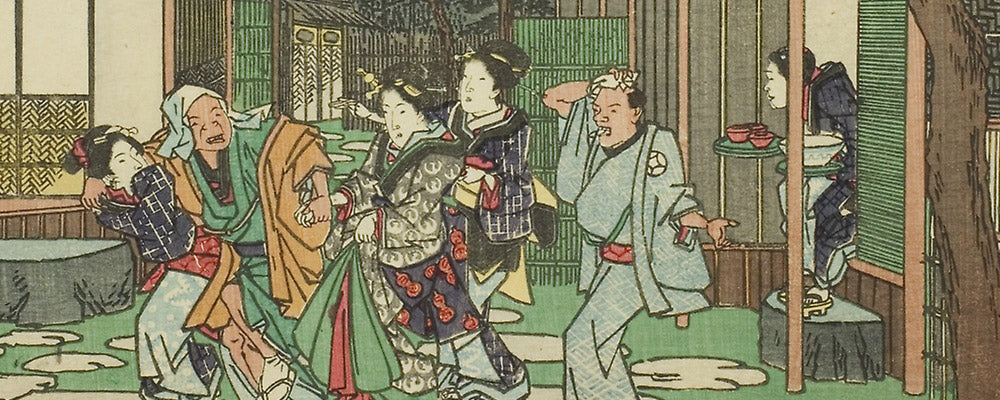
Restaurant Themed Woodblock Prints
Share
In today's world of couples taking endless selfies out at trendy restaurants, it's interesting to discover that many prominent Ukiyo-e artists also created print series around famous Japanese restaurants.
We can compare and contrast these restaurant prints because although the theme is similar, each artist brought their own styles and sensibilities to their art.
Since woodblock prints were very popular among the urban Japanese, Ukiyo-e artists were regularly commissioned by restaurants to depict their establishments in the hopes of increased publicity. As you will see in the examples I've selected below, seldom were these prints just about the restaurant, that would not be engaging enough. Famous Kabuki actors and beautiful women were often paired with the image of the restaurant in order to create a more compelling scene. We also find that some artists teamed up on the print design. One artist would create the foreground image, putting their stylings into the scene, and another artist would create the background image. I can imagine that these prints may have been more popular since fans of either artist would seek them out.
Below I've listed some of these well-known Ukiyo-e artists along with their restaurant series. I've also included representative prints, quotes, links, and personal commentary. I've ordered the artists by date of the publication from earliest to latest.
Utagawa Kunisada I (Toyokuni III) "An Assortment of Famous Restaurants of the Present Day (Tôji kômei kaiseki zukushi)" 1818–1824.
"…this series is one of the largest sets of beauty prints that Kunisada had so far designed. S. Izaards wrote on this series: "Twenty-one subjects are known, comprising portraits of geisha, low-class prostitutes, and courtesans from different parts of Edo. Women of the Yoshiwara are not among them, because the series features those restaurants where only unlicensed prostitutes were available".
This series by Kunisada has a minimalistic approach with a stark empty background on which the images rest. In the foreground is a beautiful courtesan involved in some aspect of her day. The images of the women are elegantly executed with clean lines. In the background is a rougher and more simplistic, framed image of the restaurant. Note that we will see this restaurant again, depicted by a different artist later in this article.
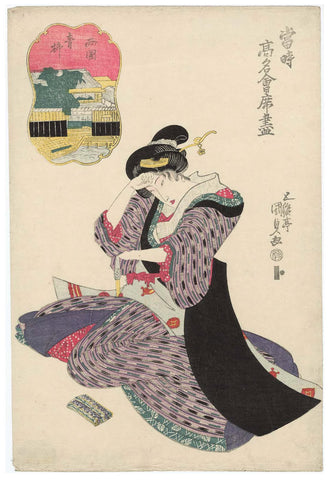
The Aoyanagi Restaurant in Ryôgoku
The second Kunisada image is the Myôgaya Restaurant in Zôshigaya. Here we see a woman on top of her futon, under thick blankets, reading. The restaurant image in the upper left seems almost an afterthought.
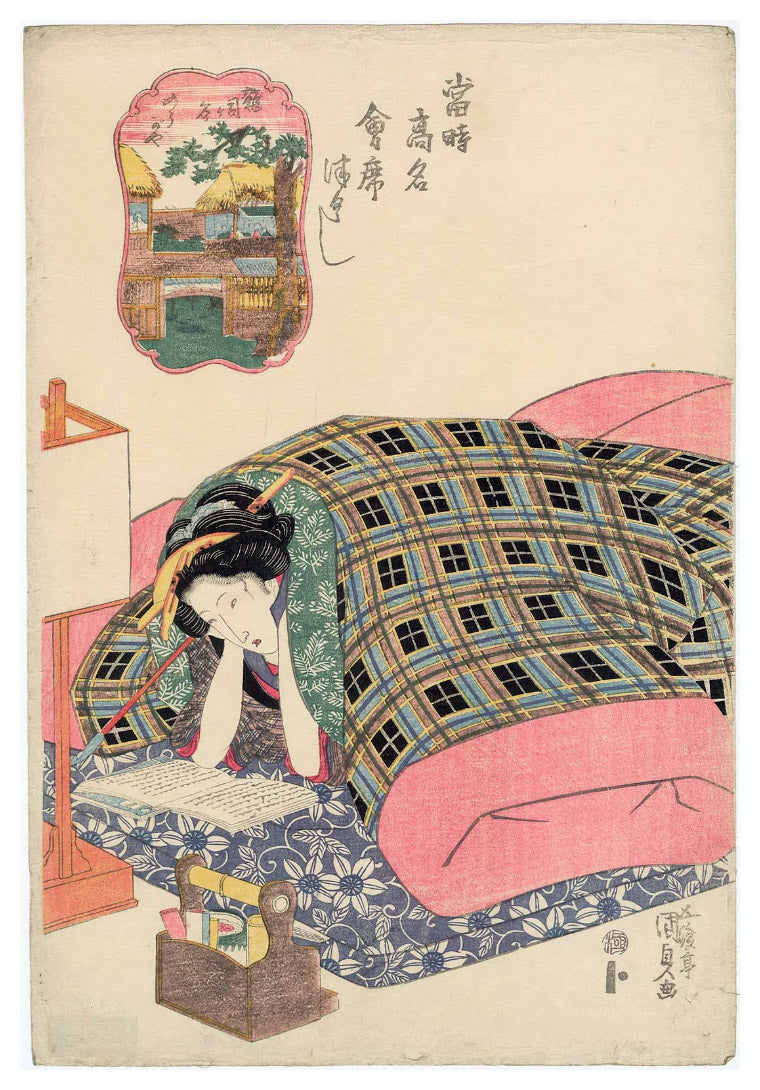
Myôgaya Restaurant in Zôshigaya
My favorite Ukiyo-e artist is Ando Hiroshige so I am excited to include his series "Famous Restaurants in Edo" Edo kômei kaitei zukushi)「江戸高名会亭尽 王子 扇屋」1838 - 1840
As with most of Hiroshige's work, the landscape takes prominence. His figures are able to add balance to the scene due to their natural depiction and the emotions they bring to the setting. Hiroshige preferred to show the common person in the scene rather than a posing beauty of the day. In the background of The Ogiya Restaurant (below), we see the customers inside enjoying the food and view of the river. In the foreground we see two women wading in the water and children playing on the river bank. We can see this is a welcoming family restaurant with beautiful scenery.
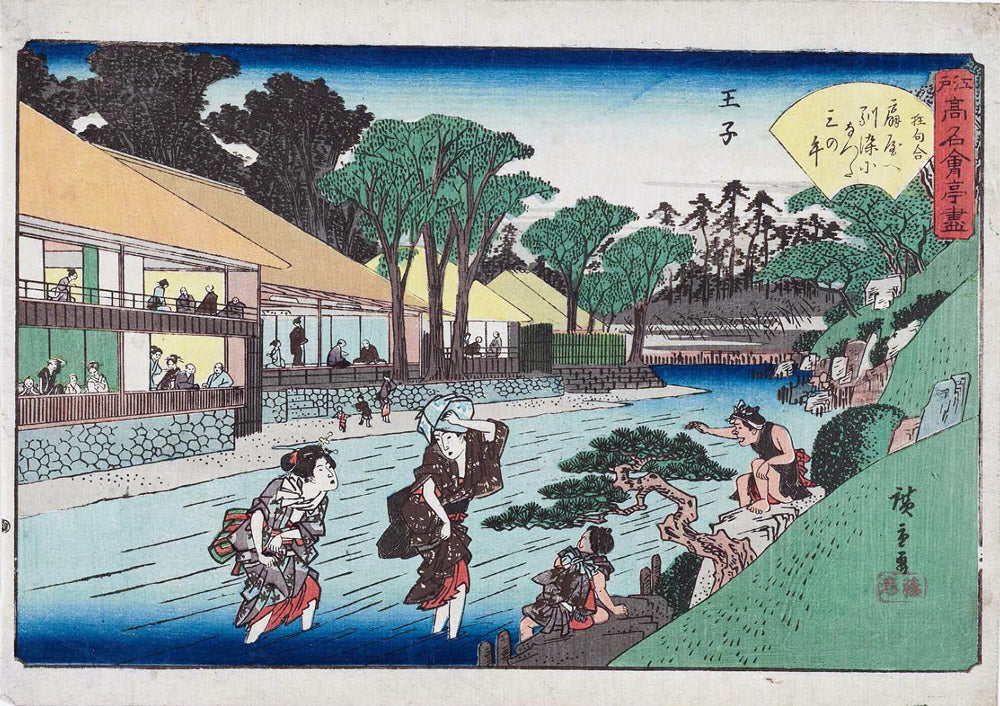
Ôji: The Ôgiya Restaurant (Ôji, Ôgiya) (about 1838–40)
The second restaurant image "The Tagawaya Restaurant in Front of Daionji (Daionji mae, Tagawaya)," is also a great example of Hiroshige's style. The print shows us several diners leaving the restaurant in the evening. The restaurant staff are all wearing the same style kimonos. One man has probably had too much to drink so he is being helped by the restaurant staff as he drags his date with him. As they depart, we see a waitress carrying the empty plates from the meal and another woman holding a lantern to help the customers find their way. As we expect with Hiroshige, the scenery is beautifully detailed and rendered. For me, the human story, the "slice of life" Hiroshige illustrates is more compelling than the setting.

The Tagawaya Restaurant in Front of Daionji
"Utagawa Hiroshige (1797-1858), a leading ukiyo-e artist who designed poetic Japanese landscape prints, also created a print series depicting fine restaurants in Edo. Hiroshige portrayed upscale places that served special meals, followed by tea ceremonies. The restaurants also functioned as meeting places for cultural activities hosted by connoisseurs. Hiroshige's depictions, accompanied by his trademark beautiful landscapes, inspired even more people to travel to Edo to experience the sophisticated delights of the city for themselves.

Japan Journeys: Famous Woodblock Prints of Cultural Sights in Japan By Andreas Marks (screenshot from book)
Utagawa Kunisada and Ando Hiroshige: Famous Restaurants of the Eastern Capital (Tôto kômei kaiseki zukushi) (東都高名会席尽) 1852 - 1853
Kunisada is responsible for the figures and Hiroshige for the landscapes and still-lifes in this series.
Charlotte van Rappard-Boon writes:
"A series designed by Kunisada and Hiroshige for the publisher Fujiokaya Keijiro, who gives his address on the prints as Tori Aburacho. The prints have a landscape, probably near the restaurants, and a still-life above. Below an actor in a stage role. The title is in a black cartouche in the upper-right-hand corner. The roles are difficult to identify. "
The Ôgiya Restaurant: depicts actor Ichikawa Ebizô V as Kumagai Naozane. You may remember this restaurant as it is the same one from Hiroshige's "Famous Restaurants in Edo" series above. In this image we see Kunisada's expressive actor In the foreground. The actors intense appearance and bulky, angled kimono dominate the image. In the background we see an aerial view of the Ogiya restaurant. We can recognize it's river setting and even see people wading in the water. The tranquil scene provides an interesting contrast to the actor in the foreground.
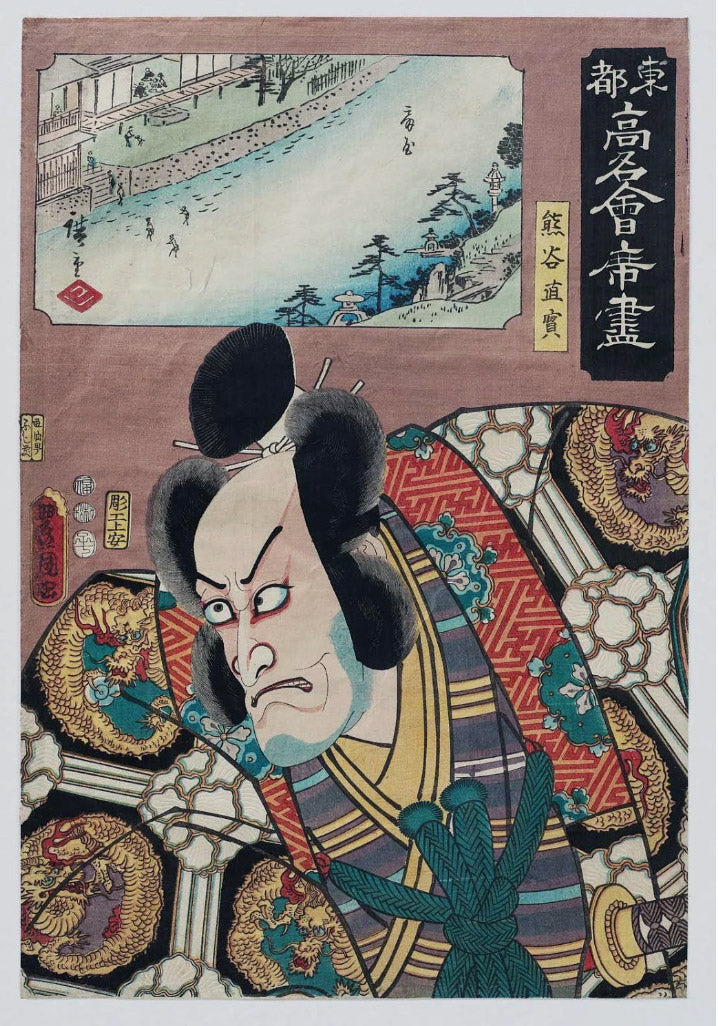
The Ôgiya Restaurant: Actor Ichikawa Ebizô V as Kumagai Naozane
In the second print I've selected from this series, we see restaurant Hirasei, at Fukagawa-dobashi. In the foreground, actor Nakamura Utaemon IV is playing the role of Kiyomori. Once again, the angled intense actor dominates the scene and appears to pop out of the frame. The strong angles of the actors body and the river above provide a lot of visual energy.
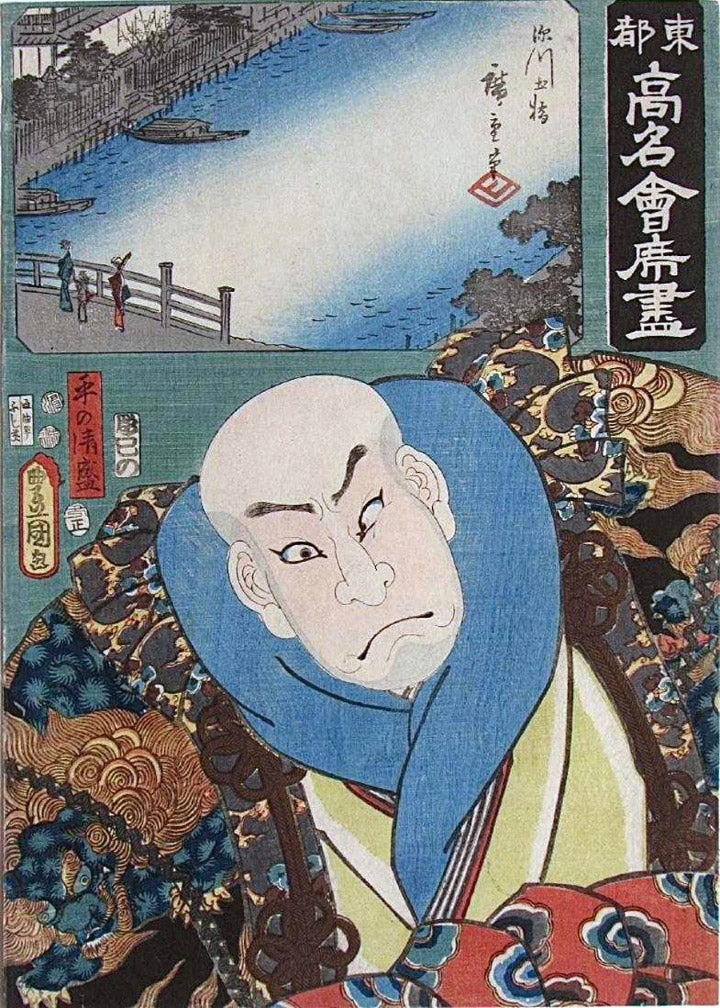
Restaurant Hirasei, at Fukagawa-dobashi. Actor Nakamura Utaemon IV in the role of Kiyomori
Kuniyoshi: Toto ryuko sanjuroku kaiseki 東都流行三十六會席 (Thirty-Six Fashionable Restaurants in Edo), 1852
In this series of restaurant prints, we again see a split image with a portrait of famous kabuki actors in the foreground dominating the image. In the background we see the restaurant exterior showing the local scenery. The subjects of these prints are more united than we've seen before. The background restaurant serves as the backdrop for the actor, instead of being intentionally separated.
"The cartouche in the right upper corner is bordered by objects from the play. The number of designs in this series is unknown. "
Although these images are less reliant on Western perspective, they are still fairly detailed and do a good job of showing the landscape surrounding the restaurant. The colors and demeanor of the actor in his role are complimented by the scenery. I especially like the old man in Nihonbashi, Kasahara-o (below). The simple kimono with great detail on the sleeves, his white flowing hair matching the snow scene behind him.
"Posthumous portrait of Onoe Kikugorô III (1784-1849) as Kasahara Zuiôken (Old Man Kasahara)
Restaurant: Okina-an, meaning "cottage of the old man", on a sign board not visible in this photo"
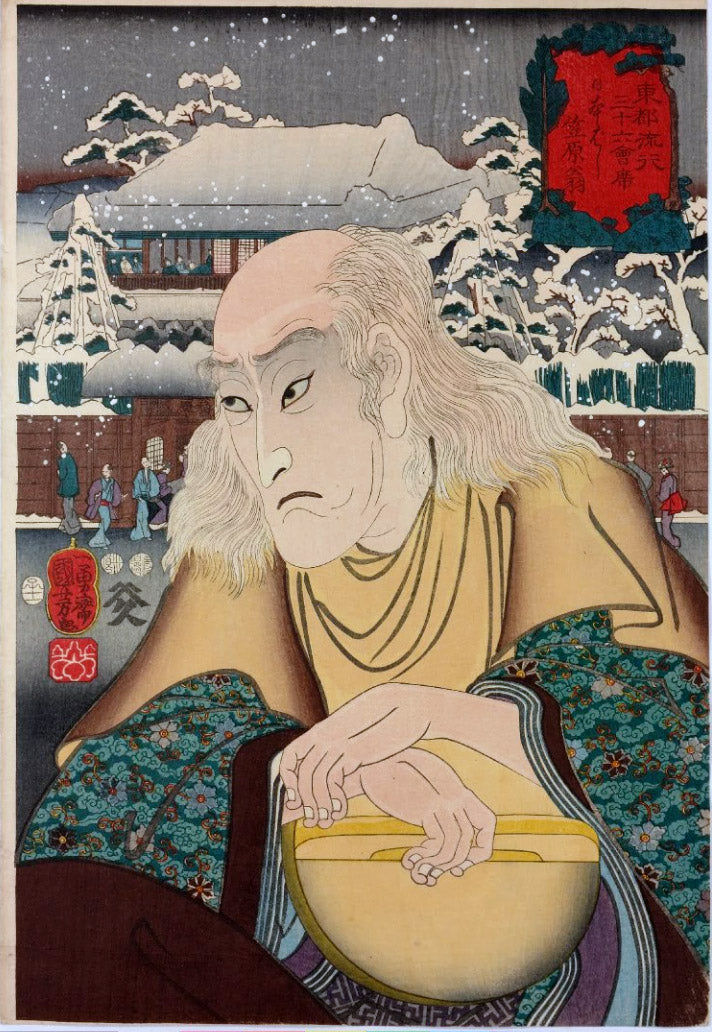
Nihonbashi, Kasahara-o 日本橋笠原翁 (Old man Kasahara, Nihonbashi)
In this next print of San'ya Restaurant we see how expertly the scene has been composed, with the actor looking like a passerby, glancing over his shoulder at the restaurant.
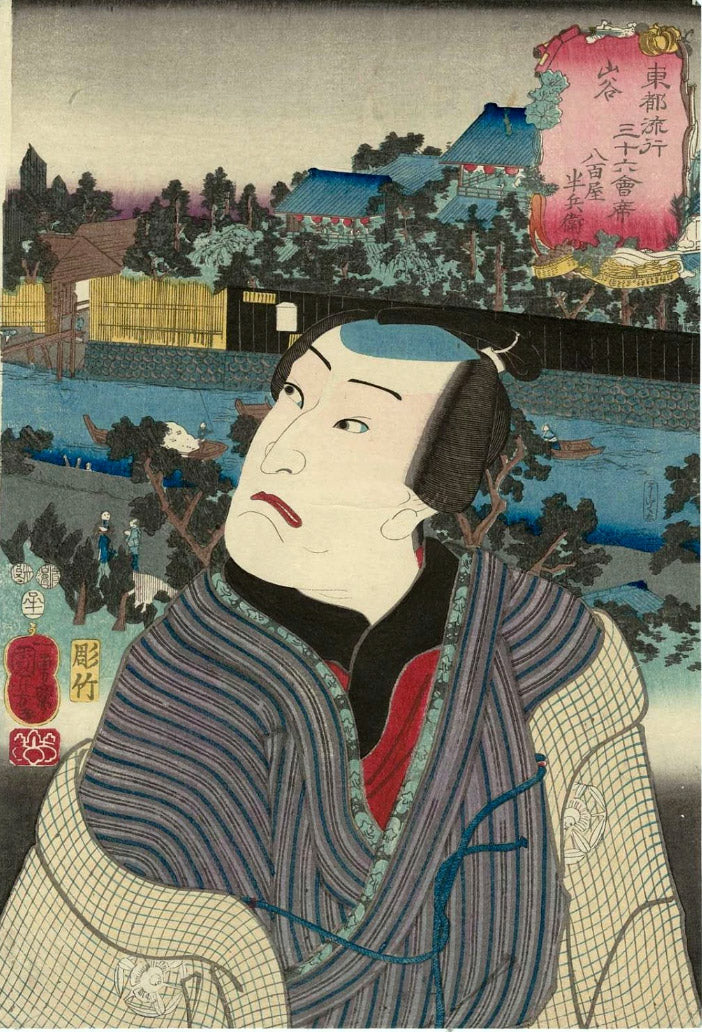
Sanya Yaoya Hanbei 山谷八百屋半兵衛
Ochiai Yoshiiku: Thirty-six Restaurants (Shunshoku sanjûroku kaiseki), 1869
"He was the son of a teahouse proprietor and attended the printmaking school of Utagawa Kuniyoshi (1798-1861) along with Yoshitoshi Tsukioka (1839-1892), six years his junior. From this time dates a life-long rivalry with Yoshitoshi whom, it is reported, he bullied at school."
The Aoyagi Restaurant in Higashi Ryôgoku (Higashi Ryôgoku Aoyagi). Here we can see the same restaurant as depicted by Kunisada I, at the beginning of this article. The boat that brings customers to the restaurant is quite apparent and must have been the restaurants claim to fame. This series focuses primarily on the architecture of the restaurant with the women in their beautiful kimonos taking up 1/4 to 1/3 of the print. Although the designs are impressive, I find the perspective a bit awkward in several of the prints in this series.
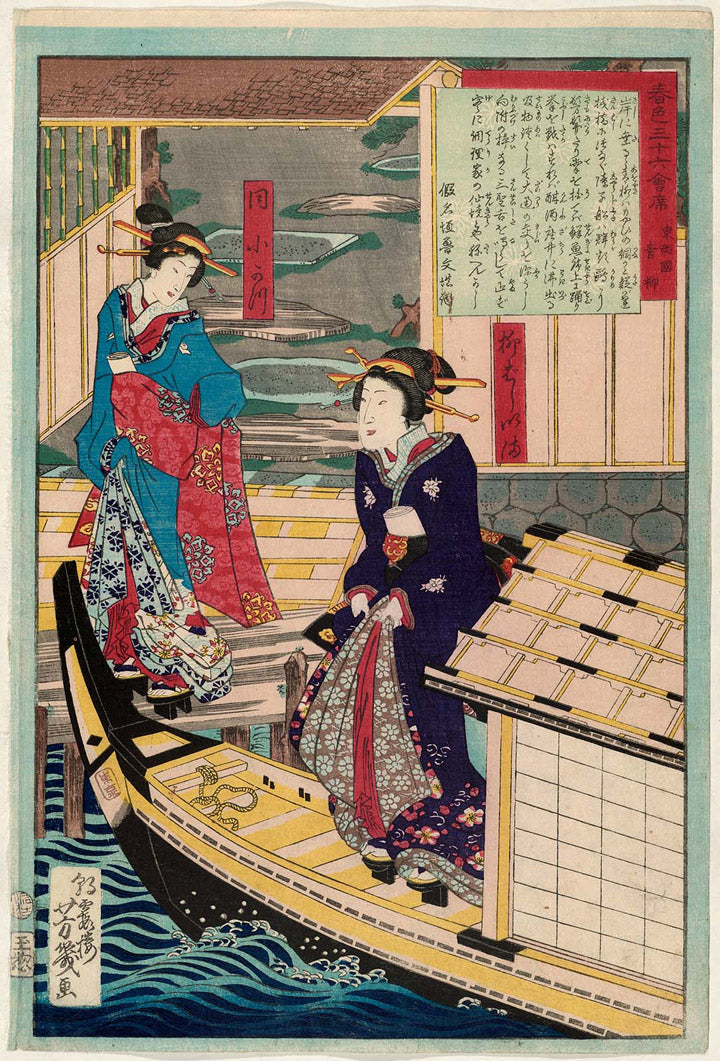
The Aoyagi Restaurant in Higashi Ryôgoku (Higashi Ryôgoku Aoyagi)

The Hashimoto Restaurant in Yanagishima
Tsukioka Yoshitoshi: Tokyo Restaurants with Some Fancy Dishes (Tôkyô ryôri sukoburu beppin), 1871
The series dates from the middle of Yoshitoshi's career. The prints are collaborations between Yoshitoshi and various students, with each pupil adding their name cartouche next to his. Each image features actors or waitresses in detailed architectural or garden settings. The emphasis on the architecture demonstrates Yoshitoshi's interest in Western-style perspective. You can see the full series online at http://www.yoshitoshi.net/series/fancy.html
"This page attempts to catalog all known prints in Yoshitoshi's series 'Tokyo ryori sukoburu beppin (東亰 料理 頗 別品 - Beautiful Women and Fancy Dishes in Tokyo)'. The title is given a wide range of translations, depending on how literal - and discreet - the translator wishes to be; in the original Japanese it seems to have a number of potential double meanings which are difficult to capture in English. ryori means 'food', 'dish', 'management' etc.; sukoburu means 'extremely', and beppin is a somewhat vulgar word meaning 'beautiful woman'. So one plausible translation is 'beautiful women and fancy dishes of Tokyo'."
The Tokiwaro restaurant at the Oumaya Bank. In this print (below) we can see Yoshitoshi's unmistakable style in the image of the woman, her head turned almost 180 degrees looking into the distance. The detailed ceiling above her ends at a garden and beautiful scenery. We can see the emphasis on the architectural components of the image. I like that the color of her geta is the same as the wood of the ceiling, this composition causes the eye to move in a clockwise manner, from the ceiling to the door jam, to the geta and then back up to the ceiling again.
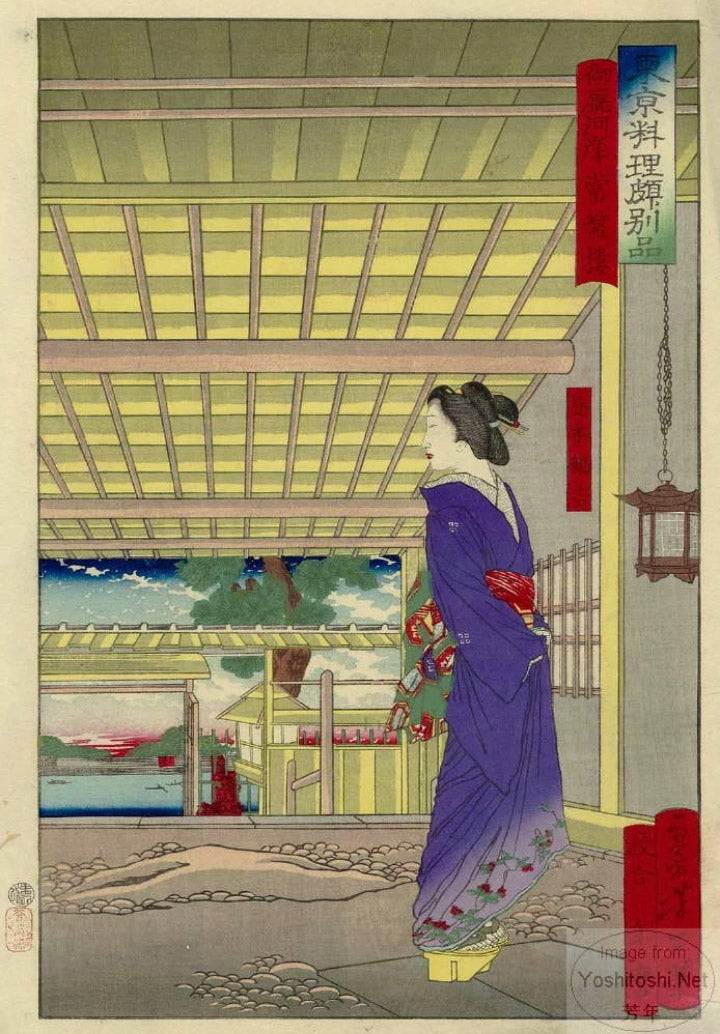
The Tokiwarō restaurant at the Oumaya Bank
The Mishima-ya restaurant at Kanasugi in Shiba. This print is even more detailed. The intermixing of architecture and nature makes for a beautiful open restaurant. It's hard to tell where the interior begins and ends. The perspective of the ceiling rafters and decorative panels is wonderfully depicted.

The Mishima-ya restaurant at Kanasugi in Shiba
Toyohiro Kunichika is one of my favorite Ukiyo-e artists and I own several of the prints from this series "Thirty-Six Modern Restaurants", 1878
Restaurant Shoeiro at Shinbashi-cho. I find this image beautifully balanced, with the strong yet ornate vertical divider between the departing customers and the restaurant interior.

Restaurant Shoeiro at Shinbashi-cho
Here is a wonderful description I found of this print.
"The print is redolent also of scenes by the new European realists in Paris at roughly the same time. Degas and Manet, for instance, experimented with these close cropped compositions; a seemingly artless slice of life, a busy street, an open door, evening revellers taking in a show or a stroll or entering a restaurant. There is much to see in this busy piece: the tree stump in the foreground with shoes resting on it reminds us of how Japan was expanding, the forests barely cleared before hastily erected buildings were imposed. The complex and sophisticated grid of timber walls and paper screens that form the interior and exterior space vie for position in an expertly articulated architectural space. Kunichika has absorbed completely the influence of western perspective and the complex space he has drawn could be easily reconstructed in plan form. Into this he has inserted contemporary and fashionable figures - the woman at right, enticing potential customers, the elegant women passing and the man in the background wearing surprisingly western clothes. Oddly, there is no food visible in the picture; the advertising, such as it is is, confined to showing the sophistication of the restaurant, its setting rather than its product."
One of my other favorite prints in this series is "Hurrying to a Restaurant" (below). This is a scene most of us can relate to. A reservation has been made and the couple is hurrying down the street towards the restaurant gate. You can see their forward motion and almost hear the sound of their geta on the path. The man is prepared for rain, carrying an umbrella. The restaurant worker beckons them from the open door. I love the detail in the entrance way, the details of the lantern and the roof, and the familiar story this image tells.
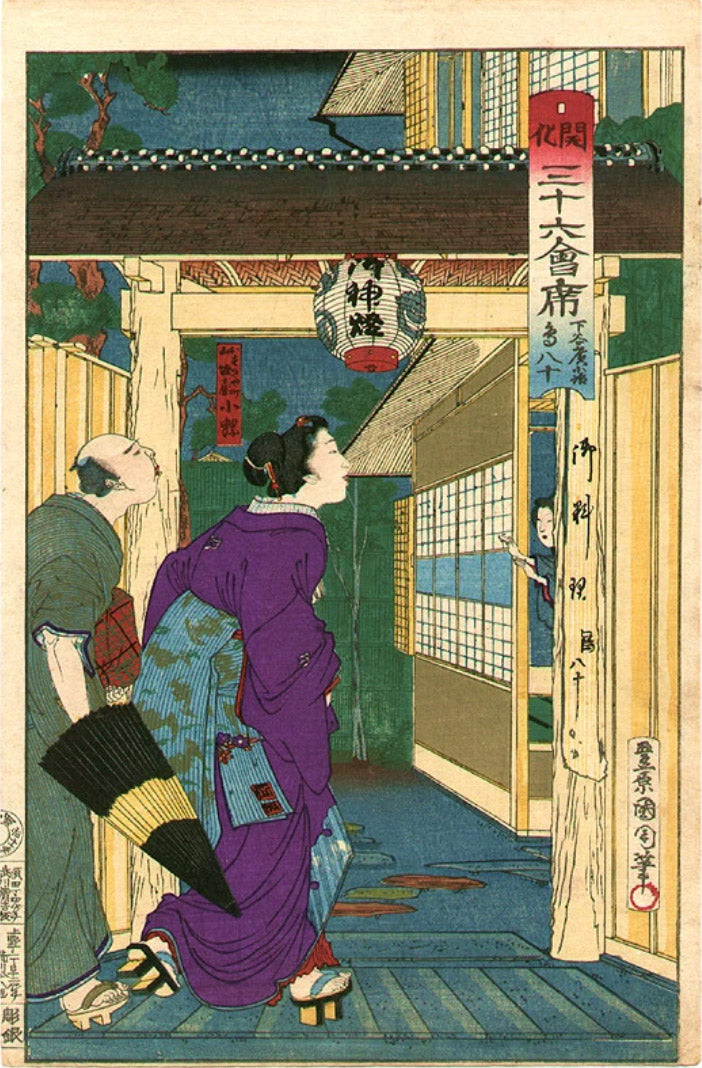
Shimayaso Restaurant at Shitaya Hirokoji
In closing.
In modern times, restaurants are constantly harangued by advertising publishers seeking to create ads for the business in directories and magazines. Was the process in Japan similar this or was it less established? I would love to get some insight into how the money and production tasks were split between the artists, and how the commission worked with the restaurant. The Japanese are such fastidious record keepers I bet there are accountings somewhere. Did the artists also enjoy comped meals?
I hope you found these prints interesting. If you have any questions, corrections, or interesting comments please reach out and let me know. Happy Collecting!